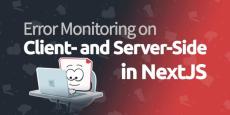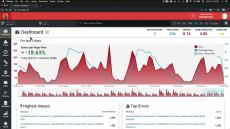|
By Jordan Griffin
Caching is one of the big draws for people using the Next.js framework. Its on-by-default, “just works” nature sets you up for high performance applications right out of the gate. However, improving web performance comes at the cost of a complex caching system. This complexity is a source silent errors in the form of stale and incorrect data. Next.js does its best to choose the right caching behavior for each page.
|
By Todd H. Gardner
Nothing changed in your code. All of a sudden, a tidal wave of errors start happening for Microsoft Edge users. What the heck happened? On August 28th, 2019, many TrackJS customers saw a sudden surge in errors from Microsoft Edge browsers: Failed to construct 'Request': Invalid Argument and Failed to execute 'fetch()' on 'Window': Invalid argument". Our Debugging blog series explores symptoms, causes, and solutions to common JavaScript errors.
|
By Todd H Gardner
NextJS is the hot JavaScript framework right now, and like all JavaScript, it can cause quite a few bugs on both the client- and server-side of your applications. One of the most powerful features of NextJS is enabling you to use your code, templates, and patterns across both the server and the client. NextJS will mostly figure out the most efficient place to run. This is super powerful and makes NextJS applications feel very fast compared to strictly client-side rendered applications.
|
By Jordan Griffin
As a Shopify theme gets more fully featured, it is likely that large amounts of JavaScript are being used to improve and expand the user experience. Making theme changes gets more nerve wracking as the amount of code increases. Did my sales go down because I broke something with the last JavaScript change? If you’re worried about that next theme publish, it’s time to start monitoring user experiences for JavaScript errors. TrackJS makes error monitoring quick and easy to do!
|
By Eric Brandes
TrackJS is the best frontend error monitoring tool. It’s all we do and we do it well. To keep it simple we have just two different JavaScript agents. One for the browser, and one for Node server environments. That’s it. No other languages or platforms are supported. Just JavaScript.
|
By Eric Brandes
TrackJS started ten years ago. To date, the only funding TrackJS ever received was the initial founder investment of $4,500 dollars (a whopping $1,500 per founder). Today, you’d call us a “bootstrapped” business. We’re proud of that fact. It means there’s no outside investors. No one to make us build a product we don’t want to build. And no one that can pull the plug if the growth chart doesn’t look like a hockey stick.
|
By Todd H Gardner
You have so many options for frontend error monitoring today, and they all do slightly different things. We looked at everyone and did a breakdown of the most important features for frontend, the problems developers run into, end user reviews, and pricing structures to see how the best vendors stack up.
|
By Eric Brandes
A few days ago a memo from logistics company Flexport leaked to the media announcing significant layoffs. Now, a tech company doing layoffs in 2023 is hardly notable. A 20% RIF here and there is almost expected. What is notable is the reason for the layoffs: Flexport is trying to achieve profitability.
|
By Eric Brandes
Alerts and notifications have been part of TrackJS since the very beginning. Our standard notification options reflect our desire to keep things simple. Over time though, our customers have asked to customize their alerts and fine tune them to specific scenarios. To support that use case, we’re releasing a new kind of notification we’re calling “Saved Filter Notifications”.
|
By Todd H Gardner
As JavaScript has grown more prevalent on the web, so have JavaScript errors. As an error monitoring service, we have a unique perspective on how errors impact the web globally, and we are constantly learning more about how the web breaks. We’re thrilled to share this report today so we can all understand it better, and build a better web. We produce this report every week, you can check it out anytime via the free Global Error Statistics report.
- November 2024 (1)
- June 2024 (1)
- May 2024 (1)
- January 2024 (1)
- December 2023 (2)
- November 2023 (1)
- October 2023 (2)
- August 2023 (1)
- June 2022 (1)
- March 2021 (2)
- October 2020 (1)
- September 2020 (1)
- June 2020 (1)
- April 2020 (1)
- March 2020 (1)
- February 2020 (2)
- December 2019 (2)
- November 2019 (3)
- October 2019 (1)
- July 2019 (1)
JavaScript Error Logging from TrackJS monitors your web applications for JavaScript errors, alerting you with amazing context about how the user, application, and network got into trouble. Find and fix your bugs fast with TrackJS.
Tracking down the root cause of JavaScript errors is expensive and time-consuming. You have to deal with remote users, bad descriptions, and browser screenshots. With TrackJS, you see when problems happen right away with all the context to fix them fast.
Error Monitoring Made Easy:
- Telemetry Timeline: Get unmatched client-side context with the Telemetry Timeline. Recreate problems fast with the user, network, and application events that led to an error. It's like having an airplane's black box for your webapp.
- Enhanced Stack Traces: Get better error context from the TrackJS's integrated function wrapping, automatic sourcemaps, and inline prettified source code. You'll spot the bugs before opening your editor!
- Easy To Install: Just drop the code snippet into your markup and you'll get great visibility into production errors. If only fixing them was this easy.
Don't leave your users stranded when JavaScript throws an error. TrackJS gives you superpowers to track the problems, and the context to fix bugs quick.













